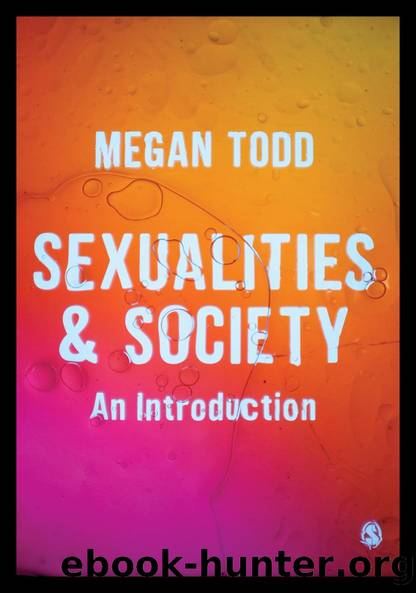Sexualities and Society by Megan Todd

Author:Megan Todd [Todd, Megan]
Language: eng
Format: epub
Tags: Social Science, Human Sexuality, LGBTQ+ Studies, General, Bisexual Studies, Transgender Studies, Sociology, Lesbian Studies, Gender Studies
ISBN: 9781526490711
Google: BZbvDwAAQBAJ
Barnesnoble:
Goodreads: 53235397
Publisher: SAGE
Published: 2020-11-11T02:50:30+00:00
Sex trafficking
Trafficking is a common feature of sex tourism, with sex workers often being shipped to where the money is. Thus, the sex tourist is not the only one travelling. Bird and Donaldson (2009) have argued that this often happens in advance of high-profile international football events such as the 2010 FIFA Soccer World Cup. It is estimated that approximately 21 million men, women and children are trafficked for forced labour around the world. This includes those trafficked for sex: estimates of the numbers involved vary from 500,000 to 1.8 million. However, as Plummer points out, the measurement and regulation of the sex trafficking trade âis notoriously difficultâ (Plummer, 2015: 59â60).
There have been various attempts to account for this growing global commodification of sex and sexualities. Richard Poulin (2003) is one of several who argue that routine sexual marketing is a direct outcome of growing exploitation under capitalism. Although it is impossible to estimate the market value of all its various forms, it is undoubtedly a major global industry which amounts to multi-billions of dollars.
This global capitalist exploitation, in particular, involves the sale and use of womenâs bodies and thus becomes connected to the development of neopatriarchy. The radical feminist Sheila Jeffreys (2008) sees this global exploitation as being linked to a vast âIndustrial Vaginaâ, where an often violent and extensive world of regulating womenâs lives becomes more and more entrenched. While the increasing involvement of (mainly) women from poorer parts of the world in sex work can be seen as enabling them to save money and support their families, many see this global explosion of sex work as part of an abusive and often brutal exploitation of people via various forms of human sex trafficking.
The trafficking of men, women and children for sexual labour, whether forced or voluntary, involves many networks, border crossings and financial transactions. Sexual trafficking also raises the question of what constitutes âvoluntaryâ involvement in prostitution. With so many women and girls struggling for basic survival in so many countries, âsurvival sexâ or âsubsistence prostitutionâ exposes such issues as the commodification of sex, and the economic, social and governmental structures that have led to these situations. Young women and men (often kidnapped in Southeast Asian countries such as Burma and Nepal) brought into this sex trade are not only exposed to dreadful suffering at the hands of traffickers and their clients, but also suffer from the horrors of the AIDS epidemic which can spread swiftly amongst sex workers. Despite programmes designed to teach about safer sex and to provide condoms, the painful legacy of sexual tourism remains; in part, this is the result not just of global economic inequalities, but also of the impact of war on these countries (see earlier section).
Women in particular, therefore, can be thought of as a resource or commodity for globalization. Women go into sex work, either being trafficked or through coercion or force, or they may remain in their home countries to service global sex tourism (Kempadoo and Doezema, 1998).
Download
This site does not store any files on its server. We only index and link to content provided by other sites. Please contact the content providers to delete copyright contents if any and email us, we'll remove relevant links or contents immediately.
Sex Workers As Virtual Boyfriends by Joseph Itiel(204)
A Trans Man Walks Into a Gay Bar: A Journey of Self (And Sexual) Discovery by Harry Nicholas(180)
Despite All Adversities by Lema-Hincapié Andrés;Castillo Debra A.;(174)
A History of Women in Men's Clothes by Norena Shopland;(167)
Transgender Behind Prison Walls by Baker Sarah Jane Stockwell Pam(163)
One Marriage Under God by Melanie Heath(157)
Transgender Employees in the Workplace by Jennie Kermode(155)
Substance Use Disorders in Lesbian, Gay, Bisexual, and Transgender Clients by Sandra Anderson(152)
Lesbian Doms: 10 Women Describe Their Most Memorable Lesbian Domination Experience by Foster Kendra(148)
Visions of Sodom by H. G. Cocks(146)
Queer TV China by Zhao Jamie J.;(145)
Confronting Religious Denial of Gay Marriage by Wallace Catherine M.;(145)
Consumed by Desire (Central Park South Book 1) by Bianca Vix(143)
Who's Who in Contemporary Gay and Lesbian History Vol.2 by Robert Aldrich Garry Wotherspoon(138)
Lesbian Mothers by Ellen Lewin(136)
Mobile Orientations by Nicola Mai(130)
A Practical Guide to Searching LGBTQIA Historical Records by Norena Shopland(128)
She and Her Pretty Friend by Danielle Scrimshaw(127)
My White Best Friend by Rachel De-lahay(125)
